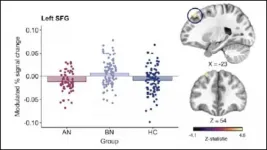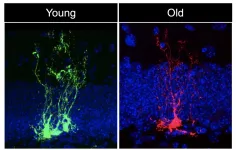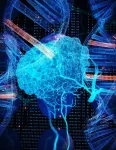(Press-News.org) Energy flows through a system of atoms or molecules by a series of processes such as transfers, emissions, or decay. You can visualize some of these details like passing a ball (the energy) to someone else (another particle), except the pass happens quicker than the blink of an eye, so fast that the details about the exchange are not well understood. Imagine the same exchange happening in a busy room, with others bumping into you and generally complicating and slowing the pass. Then, imagine how much faster the exchange would be if everyone stepped back and created a safe bubble for the pass to happen unhindered.
An international collaboration of scientists, including UConn Professor of Physics Nora Berrah and post-doctoral researcher and lead author Aaron LaForge, witnessed this bubble-mediated enhancement between two helium atoms using ultrafast lasers. Their results are now published in Physical Review X.
Measuring energy exchange between atoms requires almost inconceivably fast measurements, says LaForge.
"The reason why shorter time scales are needed is that when you look at microscopic systems, like atoms or molecules, their motion is extremely fast, roughly on the order of femtoseconds (10-15 s ), which is the time it takes them to move a few angstroms (10-10 m)," LaForge says.
Laforge explains these measurements are made with a so-called free-electron laser, where electrons are accelerated to nearly the speed of light, then using sets of magnets, the electrons are forced to undulate, which causes them to release short wavelength bursts of light. "With ultrafast laser pulses you can time-resolve a process to figure out how fast or slow something occurs," says LaForge.
The first step of the experiment was to initiate the process, says LaForge: "Physicists probe and perturb a system in order to measure its response by taking fast snapshots of the reaction. Thus, essentially, we aim to make a molecular movie of the dynamics. In this case, we first initiated the formation of two bubbles in a helium nanodroplet. Then, using a second pulse, we determined how fast they were able to interact."
With a second laser pulse the researchers measured how the bubbles interact: "After exciting the two atoms, two bubbles are formed around the atoms. Then the atoms could move and interact with one another without having to push against surrounding atoms or molecules," says LaForge.
Helium nanodroplets were used as a model system, since helium is one of the simplest atoms in the periodic table, which LaForge explains is an important consideration. Even though there are up to roughly a million helium atoms within a nanodroplet, the electronic structure is relatively simple, and the interactions are easier elucidate with fewer elements in the system to account for.
"If you go to more complex systems, things can get more complicated rather quickly. For instance, even liquid water is pretty complicated, since there can be interactions within the molecule itself or it can interact with its neighboring water molecules," LaForge says.
Along with bubble formation and the subsequent dynamics, the researchers observed energy transfer, or decay, between the excited atoms, which was over an order of magnitude faster than previously expected - as fast as 400 femtoseconds. At first, they were a bit perplexed about how to explain such a fast process. They approached theoretical physicist colleagues who could perform state-of-the-art simulations to better understand the problem.
"The results of our investigation were unclear but collaboration with theorists allowed us to nail down and explain the phenomenon," says LaForge.
He points out that an exciting aspect of the research is that we can push the envelope further in understanding the fundamentals of these ultrafast processes and pave the way for new research. The big innovation is being able to create a means to measure interactions down femtosecond or even attosecond (10-18 s) timescales. "It's really rewarding when you can perform a rather fundamental experiment that can also be applied to something more complex," says LaForge.
The process the researchers observed is called Interatomic Coulombic Decay (ICD), and is an important means for atoms or molecules to share and transfer energy. The bubbles enhanced the process, demonstrating how the environment can alter the speed at which a process occurs. Since ICD plays an important role in how living tissues react to radiation exposure - by creating low energy electrons which can go on to cause damage within tissues -- these findings are of biological importance, because it is likely that similar bubbles would form in other fluids, like water, and with other molecules like proteins.
"Understanding the timescale of energy transfer at the microscopic scale is essential to numerous scientific fields, such as physics, chemistry, and biology. The fairly recent development of intense, ultrafast laser technology allows for time-resolved investigations with unprecedented detail, opening up a wealth of new information and knowledge," says Berrah.
INFORMATION:
New York, NY - Major depressive disorder is highly prevalent, with one in five people experiencing an episode at some point in their life, and is almost twice as common in women than in men. Antidepressants are usually given as a first-line treatment, including during pregnancy, either to prevent the recurrence of depression, or as acute treatment in newly depressed patients. Antidepressant use during pregnancy is widespread and since antidepressants cross the placenta and the blood-brain barrier, concern exists about potential long-term effects of intrauterine antidepressant exposure in the unborn child.
Using the Danish National Registers to follow more than 42,000 singleton babies born ...
Stress alters brain activity in self-inhibition areas yet doesn't trigger binge-eating, according to new research published in JNeurosci.
People who binge-eat, a hallmark symptom of several eating disorders, can feel out of control and unable to stop, and often binge after stressful events. This led scientists to theorize stress impairs the brain regions responsible for inhibitory control -- the ability to stop what you are about to do or currently doing -- and triggers binge-eating.
Westwater et al. tested this theory by using fMRI to measure the brain activity of women with anorexia, bulimia, or without ...
A unique residential study has concluded that, contrary to perceived wisdom, people with eating disorders do not lose self-control - leading to binge-eating - in response to stress. The findings of the Cambridge-led research are published today in the Journal of Neuroscience.
People who experience bulimia nervosa and a subset of those affected by anorexia nervosa share certain key symptoms, namely recurrent binge-eating and compensatory behaviours, such as vomiting. The two disorders are largely differentiated by body mass index (BMI): adults affected by anorexia nervosa tend to have BMI of less than 18.5 kg/m2. More than 1.6 million people in ...
In a new study published in Cell Stem Cell, a team led by USC Stem Cell scientist Michael Bonaguidi, PhD, demonstrates that neural stem cells - the stem cells of the nervous system - age rapidly.
"There is chronological aging, and there is biological aging, and they are not the same thing," said Bonaguidi, an Assistant Professor of Stem Cell Biology and Regenerative Medicine, Gerontology and Biomedical Engineering at the Keck School of Medicine of USC. "We're interested in the biological aging of neural stem cells, which are particularly vulnerable to the ravages of time. This has implications for the normal cognitive decline that ...
Researchers have used a technique similar to MRI to follow the movement of individual atoms in real time as they cluster together to form two-dimensional materials, which are a single atomic layer thick.
The results, reported in the journal Physical Review Letters, could be used to design new types of materials and quantum technology devices. The researchers, from the University of Cambridge, captured the movement of the atoms at speeds that are eight orders of magnitude too fast for conventional microscopes.
Two-dimensional materials, such as graphene, ...
New research from McMaster University suggests the pandemic has created a paradox where mental health has become both a motivator for and a barrier to physical activity.
People want to be active to improve their mental health but find it difficult to exercise due to stress and anxiety, say the researchers who surveyed more than 1,600 subjects in an effort to understand how and why mental health, physical activity and sedentary behavior have changed throughout the course of the pandemic.
The results are outlined in the journal PLOS ONE.
"Maintaining a regular exercise program is difficult at the best of times and the conditions surrounding the COVID-19 pandemic ...
A new algorithm can predict which genes cause cancer, even if their DNA sequence is not changed. A team of researchers in Berlin combined a wide variety of data, analyzed it with "Artificial Intelligence" and identified numerous cancer genes. This opens up new perspectives for targeted cancer therapy in personalized medicine and for the development of biomarkers.
In cancer, cells get out of control. They proliferate and push their way into tissues, destroying organs and thereby impairing essential vital functions. This unrestricted growth is usually induced by an accumulation of DNA changes in cancer ...
In the earliest stage of life, animals undergo some of their most spectacular physical transformations. Once merely blobs of dividing cells, they begin to rearrange themselves into their more characteristic forms, be they fish, birds or humans. Understanding how cells act together to build tissues has been a fundamental problem in physics and biology.
Now, UC Santa Barbara professor Otger Campàs, who also holds the Mellichamp Chair in Systems Biology and Bioengineering, and Sangwoo Kim, a postdoctoral fellow in professor Campàs lab, have approached this question, with surprising findings.
"When you have many cells physically interacting with each other, how does the system behave collectively? What is the physical state of the ensemble?" said ...
Evidence is growing that health care delivered by teams is superior to services delivered by a single practitioner. Published in the Journal of the American Board of Family Medicine -- University of Minnesota, University of North Carolina, American Board of Family Medicine and the American Academy of Family Physicians researchers compared key elements from the practice of a pharmacist providing comprehensive medication management to the foundational components defined for primary care.
Based on a common health care team framework -- the Four C's of Primary Care (first contact, continuity, comprehensiveness, and coordination) -- this team ...
UNIVERSITY PARK, Pa. -- When the COVID-19 pandemic hit in early 2020, many families found themselves suddenly isolated together at home. A year later, new research has linked this period with a variety of large, detrimental effects on individuals' and families' well-being and functioning.
The study -- led by Penn State researchers -- found that in the first months of the pandemic, parents reported that their children were experiencing much higher levels of "internalizing" problems like depression and anxiety, and "externalizing" problems such as disruptive and aggressive behavior, than ...



